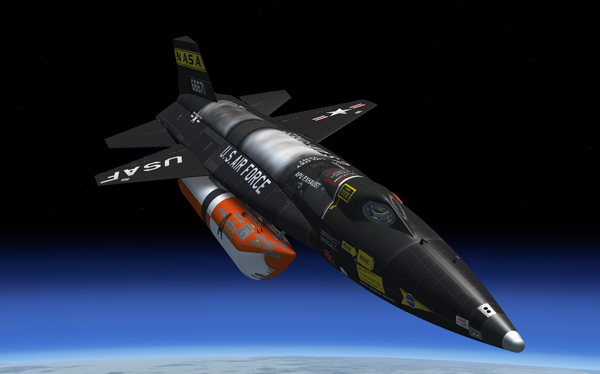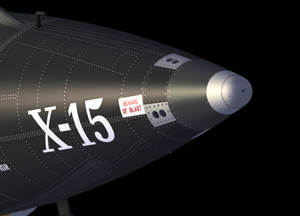
X-15A-2 SE maneuvering at high altitude.
At the time of publication, ballistic control for rocket airplanes was still not supported in either Microsoft® Flight Simulator X or Lockheed Martin® Prepar3D®. Because aerodynamic control surfaces become less and less effective above about 125,000 feet in the simulator as dynamic pressure decreases, we recommend flying the X-15A-2 addon below 200,000 feet. The simulator will still give you limited control at high altitudes, but flying will become more challenging.
Note: The highest altitude attained by the real X-15A-2 rocket plane was 249,000 feet (August 3, 1966).
We found that the best way to complete a ballistic trajectory at high altitude is to level off and maintain heading after the engine is cut off. With the nose slightly down, eventually the aircraft will lose altitude until the control surfaces become effective again. For more information about this technique, refer to "The X-15 Experience".
It is also possible to "control" the aircraft in pitch, roll and heading (bank) at higher altitudes by using the slew commands in the simulator.
Slew mode can be toggled with the "Y" key. You can use your joystick to move the aircraft on its axis. For more precise movements, we recommend using the keyboard:
Slew Mode (on/off) |
Y |
Heading North/Attitude Level |
CTRL+SPACEBAR |
Freeze All Movement |
Num Pad 5 |
Slew Forward |
Num Pad 8 |
Slew Backward |
Num Pad 2 |
Slew Left |
Num Pad 4 |
Slew Right |
Num Pad 6 |
Slew Up Slowly |
Q or F3 |
Slew Up Quickly |
F4 |
Slew Down Slowly |
A |
Slew Down Quickly |
F1 |
Rotate Left |
Num Pad 1 |
Rotate Right |
Num Pad 3 |
Pitch Nose Up |
9 |
Pitch Nose Up Quickly |
F5 |
Pitch Nose Down |
F7 |
Pitch Nose Down Quickly |
F8 |
Freeze Pitch |
F6 |
Bank Left |
Num Pad 7 |
Bank Right |
Num Pad 9 |
On the real aircraft, the ballistic control system is used to control airplane attitude at flight altitudes where aerodynamic flight controls are ineffective.
Ballistic control is provided by two independent systems which normally are operated simultaneously. Each system uses a monopropellant which is converted by catalytic action to superheated steam and oxygen and is released through small rockets in the nose section and wings. The reaction of the escaping gas causes the airplane to move about the selected axis or combination of axes.

Rocket thrusters located in the nose of the X-15A-2 SE.
The monopropellant, hydrogen peroxide (H2O2), is supplied from the APU and ballistic control propellant feed systems.
The hydrogen peroxide tank which supplies the No. 1 APU also supplies the No. 1 system of the ballistic controls. The tank which supplies the No. 2 APU also supplies the No. 2 system of the ballistic controls.
Movement of the ballistic control stick [8, fig. 5-4] in the cockpit opens a metering valve, allowing the monopropellant to enter the selected rockets. In the rockets, the hydrogen peroxide enters catalyst chambers, where it is decomposed into a high-pressure gas mixture of superheated steam and oxygen. The gases then exhaust through the nozzles. The reaction of the escaping gases causes the airplane to move about the selected axis in a direction opposite to that of the escaping gases.
There are six rockets in each system. One system includes four rockets in the nose and the two left wing rockets. The other system includes the remaining four rockets in the nose and the two right wing rockets. A dual metering valve controls flow of the monopropellant to the eight nose rockets for pitch and yaw, and a dual metering valve controls flow of the monopropellant to the four wing rockets for roll.
Flow of the monopropellant to the metering valves is controlled by two switches in the cockpit, one for each system. With both systems operating, a nose-down selection from the cockpit causes operation of the two rockets in the top of the nose section. A nose-right selection from the cockpit causes operation of the two rockets in the left side of the nose. A right-roll selection from the cockpit causes operation of the rocket whose nozzle is in the bottom of the left wing and the rocket whose nozzle is in the top of the right wing.
Stick force gradients are maintained for all three axes of operation by spring bungees. For the pitch and yaw axes, an increase in force versus deflection rate of the ballistic control stick marks half of the maximum control travel and half of the maximum force. Thus, the pilot feels the mid-point of maximum opening of the metering valve. The acceleration and velocity of airplane movement about an axis vary with the amount and duration of ballistic control stick application. The velocity tends to sustain itself after the stick is returned to the neutral position. A subsequent stick movement opposite to the initial one is required to cancel the original attitude change.
The No. 1 ballistic control system rockets also are used by the reaction augmentation system (RAS).
If either ballistic control system fails, the other system provides adequate power to control the airplane. A transitional altitude band exists wherein it will be necessary to use the ballistic control system and the aerodynamic flight controls simultaneously for maneuvering and controlling airplane attitude. The size of this transitional band is somewhat affected by airplane speed and the amount of maneuvering or attitude change required.
In this section:
Ballistic Control System Controls
See also:
Reaction Augmentation System (RAS)
Aerodynamic Flight Control System